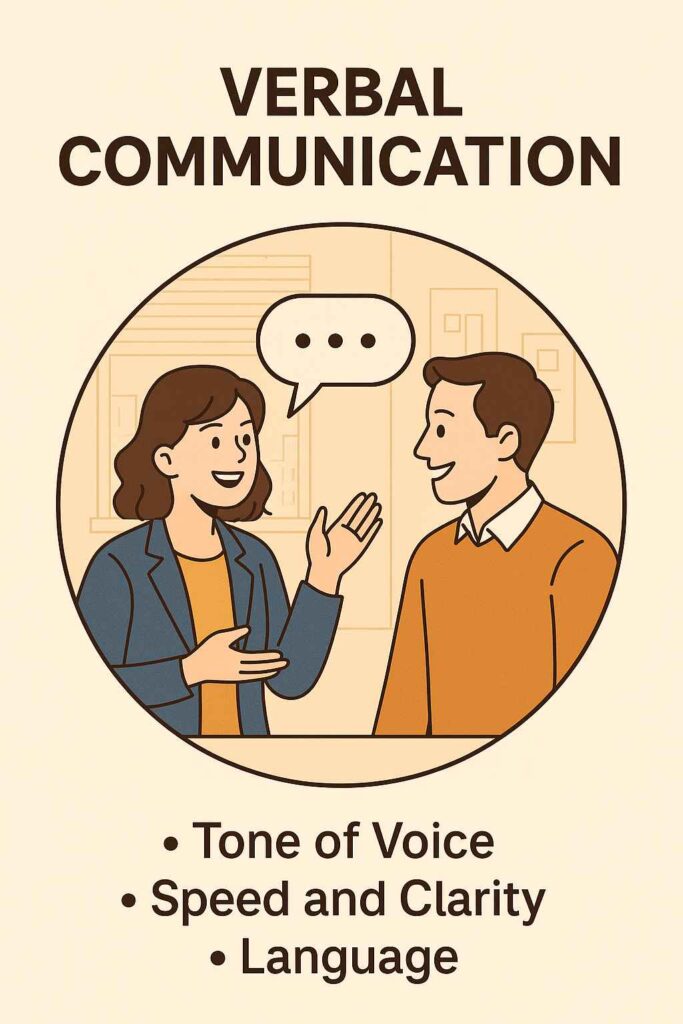Effective communication forms the basis of successful human interaction. In every situation, be it in the classroom or boardroom, conveying ideas and understanding others largely hinges upon how best one performs using the different types of communication available. The major types—verbal, non-verbal, written, and visual—are explored in this article as they relate to the shaping of our personal and professional environments.
What is Communication?
Communication can be defined as the transfer of information, thought, idea, or feeling from one individual or group to another. It necessarily involves four components: a sender, message, medium, and receiver. An effective communication process guarantees that the assumed meaning of the message is precisely meant.
Four Main Types of Communication
1. Verbal Communication
Verbal communication is the most common and direct form of communication. It includes both spoken and oral exchanges. This type involves:
- Face-to-face conversations
- Telephone calls
- Video conferencing
- Presentations and speeches
Key Characteristics
- Immediate feedback
- Tone and pitch influence interpretation
- Dependent on language and vocabulary proficiency
Verbal communication plays a vital role in negotiations, interviews, team meetings, and training sessions.

2. Non-verbal Communication
Non-verbal communication complements or even replaces spoken words. It includes body language, facial expressions, gestures, posture, eye contact, and tone of voice.
Key Characteristics
- Often unconscious but powerful
- Cultural sensitivity is crucial
- Influences first impressions and trustworthiness
In professional settings, maintaining appropriate eye contact and posture can enhance credibility and confidence.
3. Written Communication
Written communication involves conveying messages through the written word. It is widely used for documentation and formal exchanges.
Examples
- Emails
- Reports
- Memos
- Contracts
- Text messages and chat
Key Characteristics
- Permanent and retrievable record
- Can be edited and refined before delivery
- Time-consuming feedback loop
Written communication is essential for corporate documentation, academic writing, and content development.
4. Visual Communication
Visual communication uses imagery to convey ideas. It is particularly effective in simplifying complex information.
Examples
- Infographics
- Charts and graphs
- Slide presentations
- Videos
- Diagrams
Key Characteristics
- Grabs attention quickly
- Enhances understanding
- Often used in marketing, education, and training
Additional Classifications of Communication
Interpersonal Communication
This is a subset of verbal and non-verbal communication that occurs between individuals or in small groups. It involves listening, empathy, and engagement. It is foundational in relationship building.
Formal and Informal Communication
Formal Communication
- Follows a structured hierarchy
- Typically used in official meetings, reports, and organizational correspondence
- Emphasizes clarity and professionalism
Informal Communication
- Casual and spontaneous
- Common in peer interactions and social settings
- Encourages creativity and collaboration
Internal vs. External Communication
- Internal: Occurs within an organization (emails among teams, memos)
- External: Communication with external stakeholders (press releases, client communication)
The Importance of Effective Communication
- Builds strong relationships
- Enhances team performance
- Reduces misunderstandings
- Encourages feedback and innovation
- Facilitates learning and development
Global Corporate Perspective
In global corporate settings, communication training programs are pivotal for employee development. For example, multinational companies often invest in cross-cultural communication training to bridge language and behavioral gaps across regions. Programs like Dale Carnegie’s “Effective Communications and Human Relations” are adopted worldwide to empower teams with confidence and clarity.
FAQs
Q1: What are the four main types of communication?
A: The four main types of communication are:
- Verbal
- Non-verbal
- Written
- Visual Each plays a unique role in how we exchange and interpret information.
Q2: How does non-verbal communication impact professional interactions?
A: Non-verbal cues such as posture, facial expressions, and eye contact significantly influence trust, credibility, and clarity in professional settings. They can reinforce or contradict verbal messages.
Q3: Why is written communication important in the workplace?
A: Written communication ensures documentation, provides clarity, and serves as a reference for future decision-making. It is essential for maintaining professional records and contracts.
Q4: How can I improve my communication skills?
A: Improving communication involves active listening, expanding vocabulary, practicing empathy, seeking feedback, and engaging in public speaking or writing regularly.
Conclusion
Communication is multifaceted and dynamic. Mastering the different types of communication empowers individuals and organizations to express clearly, collaborate effectively, and grow continuously. In a globalized world, the ability to navigate various communication styles is not just a skill—it’s a competitive advantage.
Is the Digital Marketer Job at Risk in 2025 from AI?



